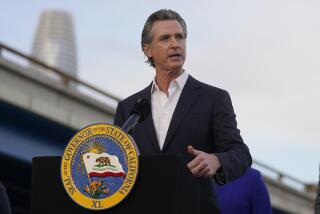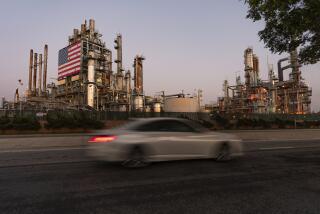Gas prices decline for 7th week
- Share via
Gasoline prices are still tumbling, the government reported Monday, while a steep drop in crude oil prices in New York futures trading could indicate that more relief for consumers is on the way.
The U.S. average price for a gallon of self-serve regular gasoline slid 7.5 cents to $3.88, its lowest level since May 19, according to the Energy Department’s weekly survey of filling stations. In California, the average fell 11.2 cents to $4.205. It was the seventh straight weekly decline for pump prices in the state, which peaked at $4.588 on June 1.
Even with the recent declines, gas prices in California are almost $1.20 a gallon higher than a year ago.
On the New York Mercantile Exchange, meanwhile, crude for September delivery fell $3.69 a barrel, or 2.9%, to $121.41, its lowest close since May 5. It traded as low as $119.50 a barrel during the day’s hectic session.
The drop in crude was part of a general decline in commodity prices, with natural gas, copper, gold, sugar, corn and other products closing lower. Gasoline futures fell 2.6% to a three-month low of $3 a gallon.
Analysts said further evidence that sky-high gas prices and the weak U.S. economy are reducing the demand for gasoline is trumping concerns about tensions over Iran’s nuclear ambitions, renewed violence in Nigeria and the threat that Tropical Storm Edouard poses to the oil-producing areas in the Gulf of Mexico.
“The thought awhile back was that demand was going to hold up pretty well in the face of higher prices, but it finally hit a wall,” said analyst Brian Youngberg of brokerage Edward Jones in St. Louis.
In addition, speculative traders appear to be losing their appetite for oil, which is down more than 16% from its top all-time close of $145.29 a barrel July 3.
“Speculation is a knife that cuts both ways,” said Jim Ritterbusch, president of oil trading advisory firm Ritterbusch & Associates in Galena, Ill. “It forces prices to overshoot on the upside, but it also forces prices to overshoot on the downside. We’re probably going to see prices drop much further than people anticipate.”
The situation in Iran is key, Ritterbusch said. The United Nations is weighing more economic sanctions against Iran after the oil exporter indicated it had no plans to abandon its nuclear development program.
If the Iranian situation is resolved without a serious confrontation, crude prices “could easily drop to $100 a barrel,” Ritterbusch said, with gas prices retreating to $3.25 a gallon nationally.
Gasoline prices have lagged behind crude prices on the way down, falling about 8% in California from the peak, about half the decline in oil futures. Analysts said gas station owners and refiners saw their profits squeezed during the first half of the year when oil prices surged and they might be trying to make back some of that money now that oil prices are falling.
“Gasoline didn’t rise as fast as oil on the way up, so I wouldn’t expect that it would fall as much on the way back down,” said Edward Jones’ Youngberg. “And the oil that’s being priced today [on the futures market] isn’t going to reach the pumps for a while.”
Demand for gasoline in the U.S. has fallen as much as 4% from a year ago, said Andrew Lipow, president of Lipow Oil Associates in Houston. The government said last month that, through May, the number of miles driven by Americans had fallen for seven straight months -- suggesting that U.S. road travel could see its first annual decline since 1980.
Besides high pump prices, drivers also are coping with inflation, a weak stock market and continuing declines in housing prices, Lipow noted.
“With all of those factors out there, I don’t think consumers are getting ready to jump back in their cars” despite the recent drop in gasoline, he said.
Demand is also falling in Europe and Asia, Lipow said. China has drastically cut back on driving and other energy use in an effort to cut air pollution before the Olympics start in Beijing on Friday. In addition, nearly 80% of Chinese consumers surveyed by marketing researcher J.D. Power Asia Pacific said they were driving less in the wake of their government’s decision in June to increase gasoline prices by 17%, the firm said in a report released Monday.
--
More to Read
Inside the business of entertainment
The Wide Shot brings you news, analysis and insights on everything from streaming wars to production — and what it all means for the future.
You may occasionally receive promotional content from the Los Angeles Times.










